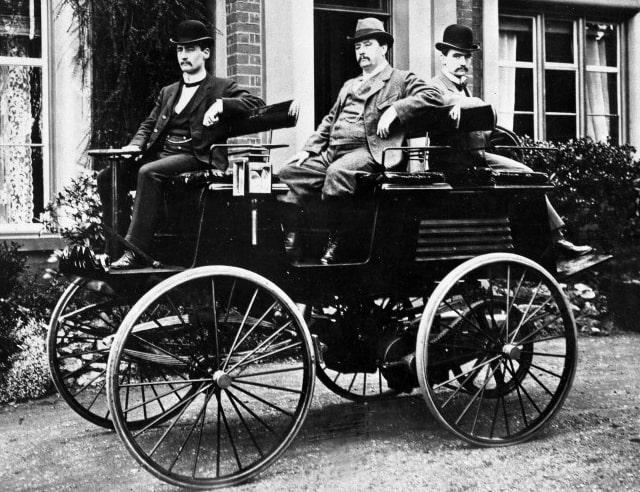The First Electric Car: A Brief History of Electric Vehicles

When people think of electric cars they generally think of the futuristic, battery-powered offerings of the last decade, however, the first electric vehicles were a far cry from the technological marvels of today. Here is a brief overview of the electric vehicles evolution over the last century.
The Origins of the Electric Car: In the Beginning
During the dawn of the electric automobile, the primary competition to EV did not come from internal combustion engines, but rather an even more environmentally-friendly form of transportation, the horse. Despite horse-powered mobility still being the primary mode of transportation in the late 19th century, the introduction of both electric and internal combustion vehicles forever mechanized personal transportation. Around the turn of the century, inventors from around the globe, most notably a youthful Thomas Edison, began developing battery-powered cars. These early EVs rapidly became popular, especially in densely populated cities, due to their silent operation and lack of noxious exhaust fumes. Other innovators of the electric car include Camille Faure, who improved the design of the lead-acid battery conceptualized by Gaston Planté; Robert Anderson, who invented the first crude electric carriage; and Ferdinand Porsche, who designed the first vehicle with an octagonal electric motor.
Over the next decade, battery-powered cars from different automakers began popping up across the U.S and continued to gain popularity. Around the turn of the century, electric vehicles were so commonplace that New York City even had a fleet of more than 60 electric taxis. By 1900, electric cars were at their heyday, accounting for around a third of all vehicles on the road. In the coming years, electric models continued to show strong sales. It wasn’t until the inception of the Ford Model T, offering unparalleled accessibility and affordability, that the internal combustion engine gained significant popularity. As internal combustion engine cars became more accessible and oil prices steadily dropped, electric vehicles fell out of favor and by the 1930s were all but extinct.
How Drivers Charged Up Their Electric Cars
Surprisingly, these early electric vehicles charged much like the EVs of today (although early chargers lacked some of the more sophisticated features of the JuiceBox smart charger). Charging cables ran from wall mounted charging stations and were plugged directly into receptacles on the car. When drivers were finished charging, the cord would simply be unplugged from the vehicle and you were on your way with a full charge. Another popular method of charging early electric cars was to simply swap exhausted batteries with fully charged battery packs, with the empty batteries then being charged centrally in a ‘battery room’.
Electric Vehicles in the 20th Century
After the all-electric car fell out of favor with the general public, they would remain a nonfactor in the auto industry for nearly forty years, however, as gas prices began to climb in the late 1960’s public interest in alternative fuel sources began to stir. Around the same time, the first manned motor vehicle to drive on the moon was battery-powered. Like nearly everything involved with early lunar missions, this battery-powered rover garnered significant interest, further stimulating public curiosity in electric motors. Automakers even went as far as to make an attempt to capitalize on this spreading interest and introduced a handful of EV models in the 70’s and 80’s. Most notably the Sebring-Vanguard Citicar which sold 2,000 units, however interest in EVs once again began to wane.
It was not until the 1990’s that public interest in electric vehicles began to meaningfully gain momentum. In 1996, GM released the EV1, an all-electric vehicle designed from the ground up that would go on to gain a cult-like following, and a martyr-like image after the program was inexplicably killed. Electric powertrains once again made a splash in the mainstream market a year later in 1997, with Toyota introducing the first generation Prius Hybrid vehicle with a Prius battery. The Prius was a near-instant hit that whet the public appetite for alternative fuel vehicles, prompting scientists and automakers alike to take a renewed interest in EV development, setting the stage for the progress of the early 21st century.
Notable Electric Cars Throughout History
• La Jamais Contente - The first electric vehicle to go over 100 km/hr.
• Walter Bersley'/ca/en/s 1897 Electric Cabs - First electric-powered public vehicle with a speed of 9 mph.
• Baker Electric Car - Built in 1897, this model is the quintessential vintage car produced by the Baker Motor Vehicle Company.
• Model T - Another vintage car model produced by Ford during 1914.
• Detroit Electric Model 47 - One of the pioneering electric cars in the 20th century.
• Toyota Prius - One of the first hybrid car models released, and put Toyota in the electric car game.
• Tesla Model S - The flagship car of Tesla Inc. released in 2012.
The Future has Arrived
In 2006, a new automaker came on to the scene, forever altering the course of electric vehicles. Wunderkin, Tesla, bore little resemblance to the American legacy automakers it sought to challenge. Hailing from Silicon Valley, rather than the Motor City, and offering a single, sporty convertible model, the Tesla Roadster garnered praise in the auto and tech realms alike. With a range of 244 miles and blistering performance numbers, the Tesla contradicted the slow, bulbous archetype of past EVs. As Tesla took the world by storm, 2010 proved a big year for EV momentum as Chevrolet introduced the first-ever commercially available Plug-in Hybrid (PHEV), the Chevy Volt, and Nissan released its best-selling Leaf.
The Chevy Volt nonetheless acted as a significant stepping stone in the history of EVs, introducing pure battery-powered mobility to the masses. With the added security of a hybrid drivetrain, the original Volt had an all-electric range of around 40 miles, more than enough for a majority of day to day driving. Many early Volt drivers have since moved on and up to fully electric vehicles after realizing the countless benefits of driving electric.
There has since been a significant influx in Electric Vehicle and Plug-in Hybrid Vehicle offerings as these early, modern EVs demonstrated to automakers the public interest in e-mobility. The tide is, as a result, beginning to turn against internal combustion vehicles. In 2019, the Tesla Model 3 beat out competitors BMW, Mercedes, and Lexus as the best selling, midsize luxury sedan, outselling the heralded BMW 3 Series and Mercedes C-class combined.
A Look Into The Future of Mobility
As we look back at the long history and recent progress of electric vehicles, it is equally important to look to the future. Facing increasingly rigorous emissions standards and growing consumer support for electrification, automakers have put the pedal down on EV development. Record numbers of battery-electric and plug-in hybrid models are set to hit the market in coming years as EV market share continues to rise. These new EV offerings will cover nearly every market segment, from compact SUVs to semi-truck, providing consumers with an all-electric option to fit their exact needs. The range of electric vehicles has gotten longer, too, with the longest range electric car being the Lucid Air Dream Edition Range.
The question of, “What is better? Electric or gas cars?” might still stand, but the days of internal combustion engines and reliance on fossil fuel are numbered.



